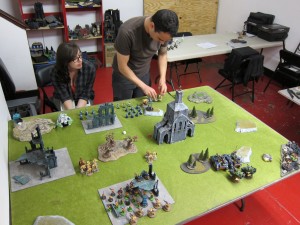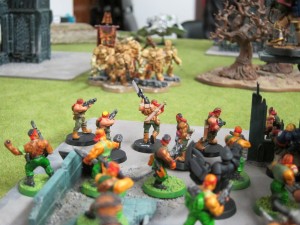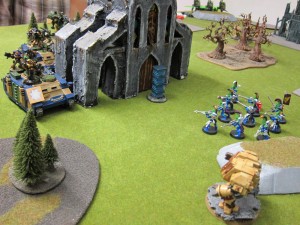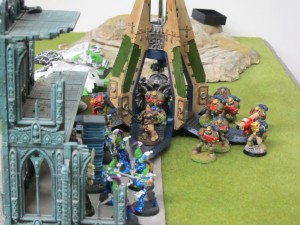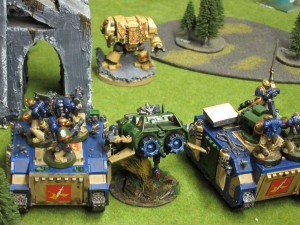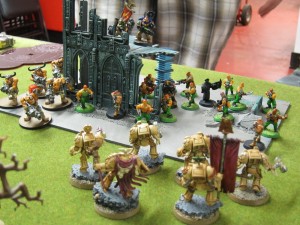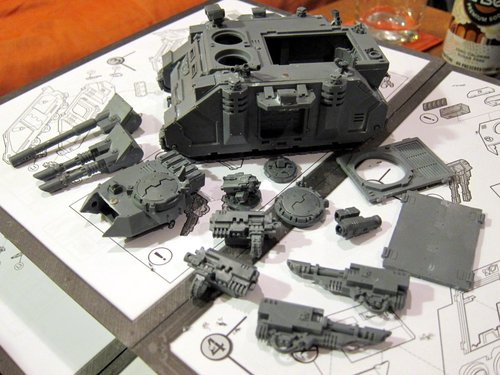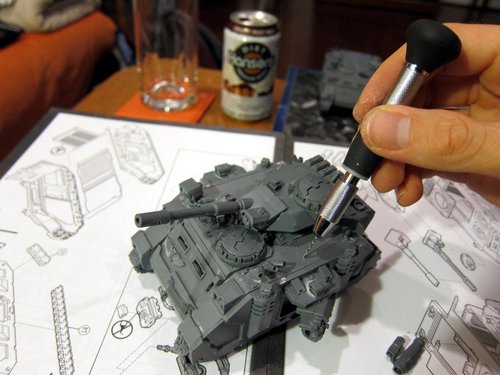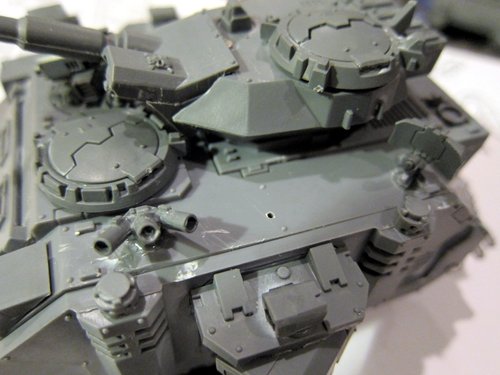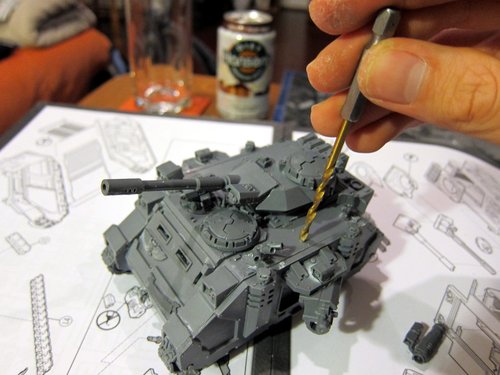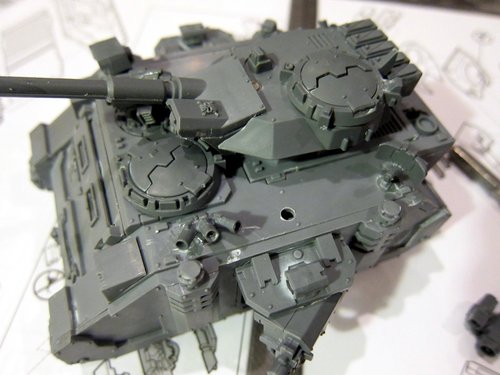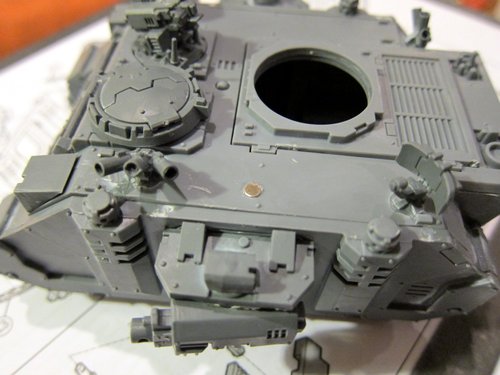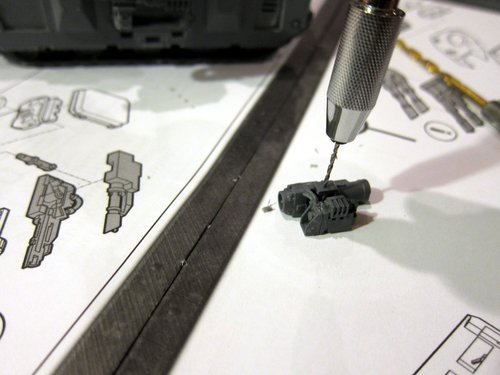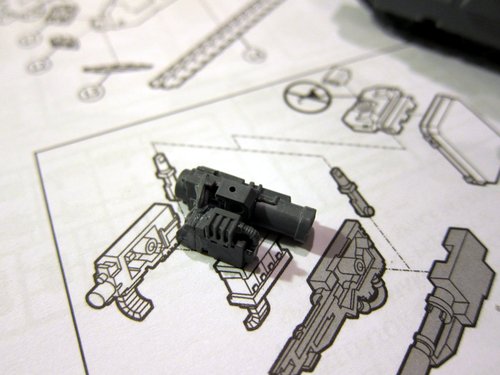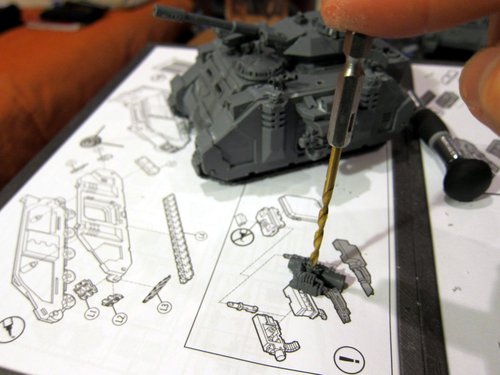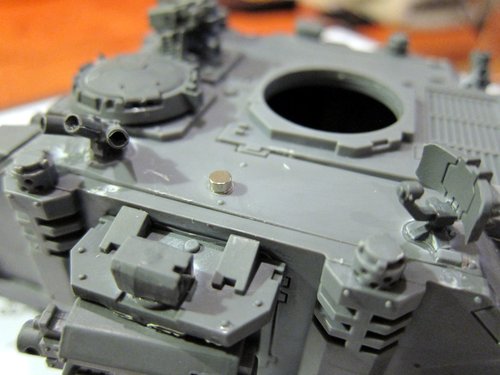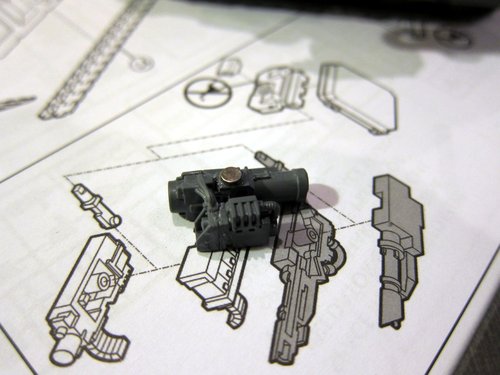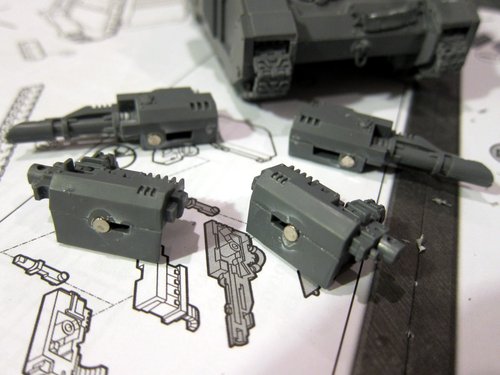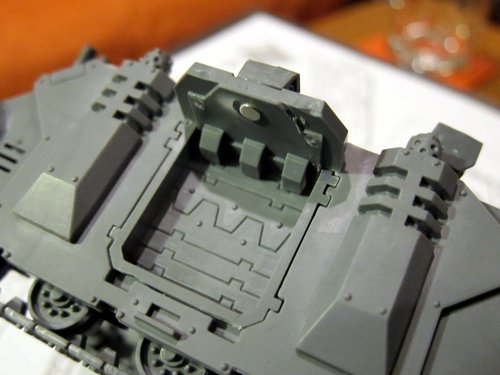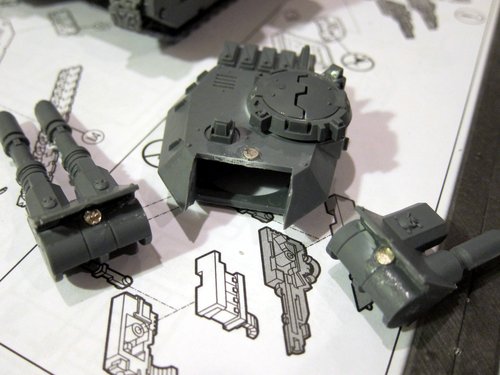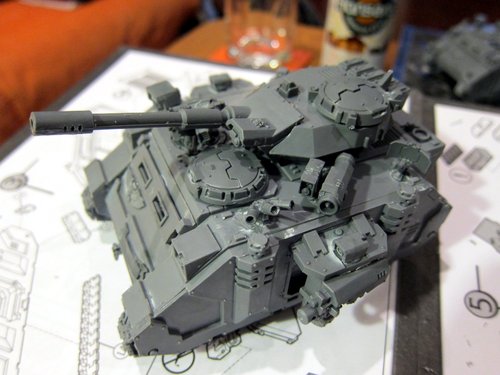![]() Colin, Jason, Justin, Lovell, and I went out for Redcap’s December monthly tournament yesterday. Three games, 1000pts, standard missions and force organization. Final standings:
Colin, Jason, Justin, Lovell, and I went out for Redcap’s December monthly tournament yesterday. Three games, 1000pts, standard missions and force organization. Final standings:
- Chaos Marines (Chris)—16
- Tyranid (Byron)—11
- Tie: Chaos Marines (Colin) and Chaos Marines (James)—10
- Space Marines (Joe)—9
- Eldar (Justin)—8
- Dark Angels (Jason)—7
- Tyranid (Lovell)—4

Missions were drawn from the standard rulebook with straightforward bonuses:
- Big Guns Never Tire/Hammer and Anvil/Bonus: No enemy units in their deployment zone.
- Crusade/Dawn of War/Bonus: Warlord ends game in enemy deployment zone.
- Relic/Vanguard Strike/Bonus: Your warlord slays enemy warlord.
These were my first games in 6th edition after a good length hiatus in general. In addition to the PAGE guys going, this tournament worked out well as a re-introduction. The low points limit kept out crazy units and complicated rules, as well as giving plenty of time to play.
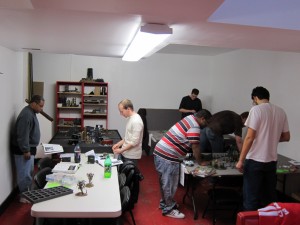
Army
I took a pretty simple list, inspired by two criterion:
- I was willing to bend on this, but I really wanted to take a fully painted force.
- I wanted to keep everything super simple and familiar to me so I could just focus on the core 6ed rule changes.
I wound up taking 1000pts exactly:
- Captain Angholan (Vulkan)
- Sternguard x10 w/ Powersword, 6xCombi-Meltas, Multi-Melta, Drop Pod
- Tactical x10 w/ Powerfist, Plasmagun, Missile Launcher, Razorback w/ Hunter-Killer
- Tactical x10 w/ Chainsword, Meltagun, Missile Launcher, Rhino w/ Hunter-Killer
In the end everything was painted except the magnetized hunter-killers and two guys’ bases.
Round 1
First I faced Justin and his Eldar. All four objectives wound up tightly clustered near the center of the table. For my part, I’d encouraged this because I figured it would lead to more close combat scraps over objectives, which I figured my stalwart Marines would tend to win.
In the end I claimed a massacre, but it was super bloody. I only had five guys plus the captain and a Rhino left, facing fifteen or more Eldar. However, the Eldar had all been pushed away from the objectives and had not claimed any bonuses. One interesting thing about this was that much of it was done by tank shocking the Eldar away from objectives. This was done a couple times, but a late game charge by the remaining empty Rhino cleared the Eldar off their last objective, swinging the Kingbreakers from a major victory to a massacre. Also of note was that my captain’s Warlord Trait made him a scoring unit. In the end it didn’t matter in some sense as a single tactical Marine was left standing on the central objective with him, but it seemed powerful that the highly robust (2+/3++) Angholan would have been able to hold that objective all by himself.
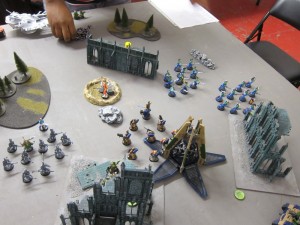
Usually you should try to *not* be completely surrounded…
Round 2
Next came Chris, the eventual winner, and his Chaos Marines. He was able to tightly cluster three objectives in his zone. I put my two pretty far away, more or less tucked into a relatively remote corner. The final score on victory points wound up being 10–8, Chaos.
For the most part this was a fairly close game. Other than three Rhinos, Chris didn’t have a ton of mobility, so I felt fairly safe leaving just a combat squad each to guard my two home objectives, and they indeed wound up unmolested the whole game. The Sternguard dropped into the heart of the Chaos objective cluster and did a reasonable job of gumming up everything in there. Between pressure from them and a flanking sweep from the remaining Tac Marines, the Chaos right side was rolling up and at least a third objective definitely achievable, if not a fourth. As expected though, a pair of Obliterators came down behind that flank and I decided to fight them. On the one hand, they got pretty lucky and rolled a large number of 5+ saves for several turns, stalling out my entire offensive. On the other hand, I maybe should have just ignored them; it was probably a mistake to fight them rather than just roll on. They would have been lethal, but if the push had just kept going it may have been able to gain enough distance to settle on the objective and effectively ignore them. Contrarily though, they’re not as slow as they used to be with the changes to Slow + Purposeful, so that would not have been as effective a move as in 5e.
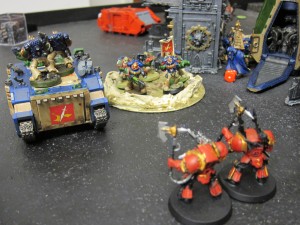
Oblits begin to stall out the Kingbreakers’ flanking rush.
One other thought about the mission was that allowing the first player to place an uneven number of objectives seems like a significant advantage. Especially when they’re playing armies that want to get into a close quarters fight, it seems unfortunate for the first player to be given a significant lead from the get-go and be able to play more defensively.
Also, between all the Traits, Boons, and Demon Weapons, even fairly standard Chaos Lords seem to be able to throw down an astounding number of close combat attacks now.
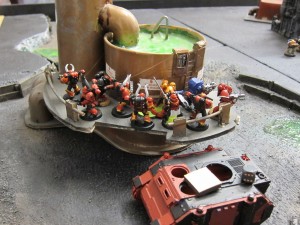
Chaos hunkers down around the local watering hole…
Round 3
After that slight loss I went against Byron and his Tyranid. To some extent I was starting to fade here. Between getting up super early to cram for a few hours on the new rules and already playing for 4 hours, it was a fair bit of 40k from a cold start. Compounding that, I don’t have a ton of experience against the latest Tyranid codex. It seems like it has fared well with the new rulebook. I thought it also well suited for the Relic mission. A Tervigon with Iron Arm cast on it is a pretty imposing scoring unit for carrying the relic around…
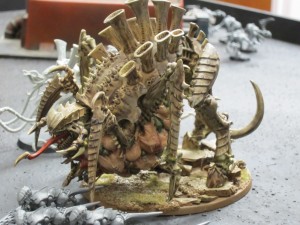
Oh yeah, you bad! (this Tervigon’s actually in Lovell’s army)
I think my biggest problem though was not having any psychic protection. It’s tough to fit two Marine HQs into 1000pts and Vulkan’s so useful that I’m not sure I’d have taken a librarian even if I hadn’t consciously set him aside as I wouldn’t have been really up on the new rules for using him. However, a hood or something would be really useful. Most of the Tyranid spent the game walking around covered by a Telekine Dome, both making them extraordinarily harder to kill than they usually are, and hurting my own guys as shots bounced back. If I’d been able to counter that at least once in a while things could have turned out much differently from the massacre it wound up.
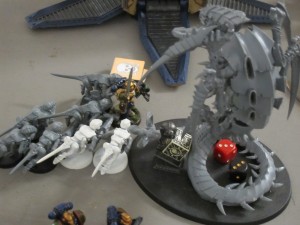
Generally, this kind of scene won’t end well for humanity…
General Analysis
I knew this going on and ignored it in favor of a simple and familiar army, but my list had really a lot of points spent on Sternguard for this size game. There generally aren’t enough juicy units lying around for them to recoup points in the alpha-strike fashion I tend to play them. They did ok, but for this size battle there just aren’t big enough targets for them to be really effective in that way.
As noted, I’ll probably have to reevaluate my tradeoffs on different HQs at different point levels. Vulkan was definitely very useful throughout the day, as usual. But a librarian would have dramatically altered the final round. I haven’t fully digested the new rules and tables, but I could believe 6ed will accelerate the already strong resurgence of psychers as something you need to be able to at least counter.
The new missions also place even more emphasis on scoring units. Even setting aside inevitable casualties, if you don’t have the ability to credibly hold at least three objectives, you’re probably not going to be competitive. It would be good for me to work in one or two cheap rearguard scoring units, potentially Guard or Tau allies.
In general I’ll have to really study the missions. For example, in the Relic mission, it almost seems not worth really worrying about the Relic and instead focusing on taking and denying the bonuses as together they’re worth just as much. I’ll also have to think about the tournament format Redcap’s has converged on. Being able to take that single tournament bonus point in just a mission or two could really make the difference.
6th Edition
Overall I’m super happy with sixth edition 40k as I learn more about it. Continuing the vast improvements made in 5th, the rulebook seems even better written and less ambiguous.
I’m very excited about the changes to vehicles, I think they got cut down quite a bit but without clearly going too far. Even if nothing else, it’s great to have a much more predictable idea of when a vehicle will go down, based on chipping away at hull points.
I’m also pretty excited about Allies. I think it can lead to a bit of gameyness and some hard-to-justify fluff. However, it does open up a lot of options for mixing and matching to counter strengths and weaknesses. It’ll also allow a lot more modeling without the commitment to fielding an entire army. I’ll never field a full Guard or Tau force anytime soon, but I’m pretty excited to now have a realistic reason to put some together.

Allies = Interdimensional BFFs?
I have mixed feelings about putting wounds on the closest models. It’s more intuitive to newcomers than the previous wound pools, but certainly didn’t speed up gameplay—repeatedly rolling individual wounds in cases where it matters can be extremely slow. In thematic ways it’s unfortunate now that there’s a lot of incentive to not have your sergeants or whatnot leading the group. It also slows things down as much more care now has to be placed on very precise model placement, where everybody is in the unit. To me this is unfortunate as I don’t generally find it that interested, and often problematic: There’s only so much precision you can have with these kinds of games, between terrain, eyeballing tape measures, and so on. That focus on precise placement is a big part of what I really don’t like about Warmachine/Hordes and Battlefleet Gothic, both otherwise excellent games. On the other hand, it can bring a lot of strategy and narrative to movement. For example: Do you put Vulkan and his crazy armor up front, shielding the way for a tac squad as they rush headlong into torrents of fire? That’s a thought provoking tradeoff to have to make, in addition to having a great dramatic component.
All in all though, things seem even more streamlined and yet more strategic, and I was already pretty happy with 5th edition 40k.
There are a few more photos from the day in my Flickr gallery.
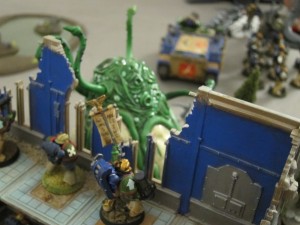
Not typically what you want to see over the castle walls, no…
